-
Posts
14,343 -
Joined
-
Last visited
-
Days Won
25
Content Type
Profiles
Forums
Blogs
Gallery
Events
Store
Posts posted by Ed_Haynes
-
-
A classic PDRA problem:
- We have its image.
- We know its name.
- We have no clue about anything else.
Faid Djamanudin Afghania
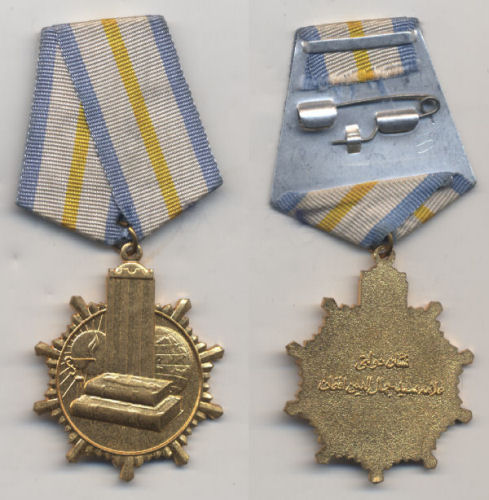
 0
0 -
Order of People's Friendship
Simular to the Soviet Order of Friendship of Nations.
The award " Friendship of Peoples " was founded 24 December 1980.
The award was given to citizens of PDRA, foreign citizen, to enterprises and the organizations, to provinces and cities.
Rewarding by an award was made for:
- oustanding work in business of propagation and strengthening of brotherly friendship of all tribes and nationalities of Afghanistan;
- for achievements in the work directed at growth and strengthening of the national economy;
- for excellent service in the state and national construction;
- for merit in political development, enrichment and a mutual cultural exchange of tribes and nationalities of Afghanistan, for active participation in education of citizens in spirit of friendship and proletarian internationalism, and fidelity to the native land;
- for merit in business of strengthening of defensive power of the PDRA;
- for merit in business of strengthening of the the world and the friendship of peoples.
The award presumably became obsolete with the collapse of the PDRA in 1992.
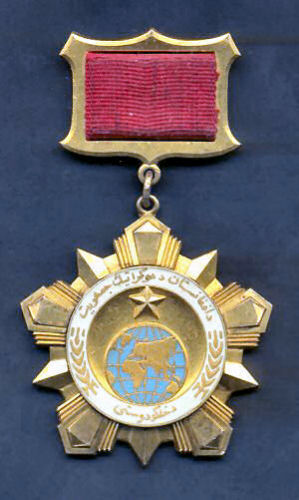
 0
0 -
Medal for Gallantry
Similar to the Soviet Medal for Bravery.
The Medal was founded December, 24, 1980. The medal awarded military men, volunteers and foreign citizens for courage, stability(resistance) and courage in fights with enemies of Democratic Republic Afghanistan. The award presumably became obsolete with the collapse of the PDRA in 1992.

 0
0 -
The 1987-92 variety. Enamel slightly the worse for wear.
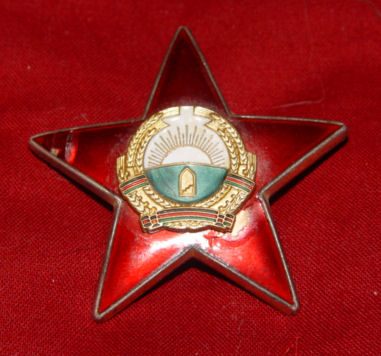
 0
0 -
Order of Gallantry
Awarded for gallantry, roughly equivalent to the Soviet Order of the Red Star.
Established 29 October 1985. The award presumably became obsolete with the collapse of the PDRA in 1992.
There are believed to be two varieties, (1) 1985-87, with an open book as part of the central design (shown below), and (2) 1987-92, without the book (next post).
This one number 1248, with certificate to Vladimir Yurevich Loginov, 20 April 1987.
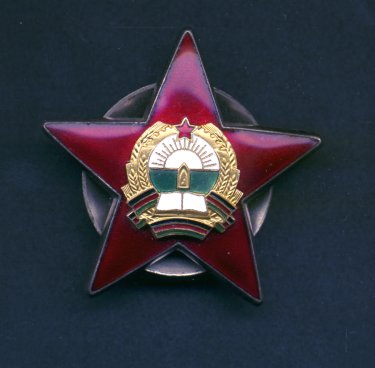
 0
0 -
Order of the Red Banner
Roughly equivalent to the Soviet award of the same name.
Established 24 December 1980. The award presumably became obsolete with the collapse of the PDRA in 1992.
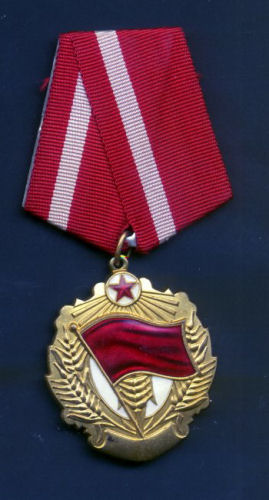
 0
0 -
During the Great Proletarian Cultural Revolution, all awards were looke down on (as were ranks in the military) as being counter-revolutionary, rightist, Stalinist, and feudal. The recipients kept them, but wearing them was considered very naughty and could land you in a world of hurt and "criticism" by Chairman Mao's Red Guards. Many recipients still have them, and while wearing them has become more acceptable in today's socialist-capitalist China, few recipients survive.
There was a good article in JOMSA a few years back, let me look.
It is my clear sense that they were intended to replace the utter chaos of regional, army-specific awards.
0 -
And it is extremely nice to be able to share things with appreciative e-friends. (Some how, my wife doesn't understand me . . . and the medal-friends in my custody . . . !)
And we do have the duty to keep the memory of the recipients of these medals alive.
 0
0 -
Thanks, Steen,
Let me get out the documents and I will get back to you.
Ed
0 -
This set sure made MY day!
Always glad to help . . .
0 -
What is it? Picked it up in Delhi back in the 1970s. For a whopping Rs. 5. Bronze with a minimal silver wash.

 0
0 -
Sanad-i-Bahaduri / Certificate of Bravery
Awarded for low levels of bravery not warranting the award of a higher decoration. In essence, a mention in dispatches award. Sources are unclear whether this is a certificate alone, with or without a representative ribbon, or whether it was even issued at all.
Awarded to those who rendered meritorious service in the field but fell short of qualifying for a decoration. While it appears to have been a sort of mention-in-dispatches award, some sources suggest some sort of medal accompanied the award. Known to have been awarded 12 times in Southeast Asia.
To understand the award better, a sample recipient would 2/Lieutenant Dura Badadur:
?In March [1944?], in the Central Sector [of the Burma front] 2/Lt. Dura Bahadur was sent to contact a Gurkha unit of the British army. Dura Bahadur, risking his life, reached the Gurkha unit, through the enemy lines, and talked with them for half an hour.
?The Gurkha unit promised to do propaganda for the I.N.A. in other Gurkha units. 2/Lt. Dura Bahadur also told them that I.N.A. wants to capture that position and that it is an important point for the I.N.A. from the military standpoint.
?The same day, a few hours later another I.N.A. officer met those people and they surrendered that place according to the instructions of the I.N.A. officers.?
0 -
Tamgha-i-Azadi / Medal of Freedom
Established in 1942. Awarded to all soldiers in the Indian Legion who had served for a year and a half in the unit. The medal is sometimes seen without swords, but this seems to be a fantasy fraudulent postwar restrike. It is estimated that only about three hundred of these decorations were manufactured in Europe; South-East Asian manufacturing and award has not been established.
This is a restrike from original dies by Rudolf Souval of Vienna.
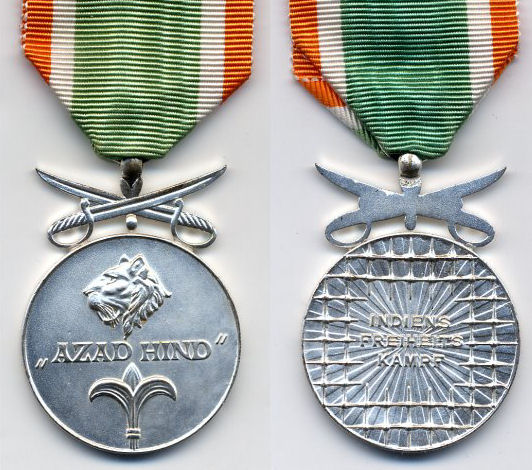
 0
0 -
Tamgha-i-Shartu Nash / Medal for Destroying the Enemy
Not much is known about this award. It was established (date unknown) by Bose after he was in Southeast Asia. Awarded to members of the Indian National Army or to civilians for the killing or capture of a British or American officer or enlisted man under conditions where individual bravery and initiative were involved. This appears to be the only Free Indian award distinctive to the Asia Theater.
The award came in two classes: first class, for those members of the I.N.A. who exhibit conspicuous gallantry and devotion to duty in killing or capturing alive any British or American officer or other rank, either in single combat or in group fighting, where qualities if individual initiative and bravery come into play; second class, for those members of the I.N.A. who kill or capture alive any British or American officer or other rank, either in single combat or in group fighting, where qualities of individual initiative and bravery come into play.
To understand the award better, sample recipients would the awards in the second class to Havildar Pir Mohammed and Havildar Hakim Ali:
?In the Arakan Sector [of Burma], Hav. Pir Mohd. And Hav. Hakim Ali, along with other men, were sent on patrol duty on February 5 [1944?]. On the way they came across a small unit of the 30th Indian Cavalry. Our patrol tried hard to persuade this unit to join the Azad Hind Fauj [= Indian National Army], but as they were under command of a British N.C.O., they did not respond. Upon this Hav. Pir Mohd. and Hav. Hakim Ali fired at them with Tommy guns and killed a British officer and a soldier. The enemy unit who was on patrol took to his heels.?
No specimens of the award have been observed or reported.
0 -
Tamgha-i-Bahaduri / Medal of Bravery
Established in 1942. The medal with swords was awarded for bravery, while the medal without swords was awarded for distinguished service to the Indian Legion or to the Free Indian Government. This decoration carried with it an annual stipend of Rs. 150 when awarded with swords. It is estimated that only about three hundred of each division these decorations were manufactured in Europe; South-East Asian manufacturing has not been established. Known to have been awarded 21 times in Southeast Asia.
To understand the award better, a sample recipient would be Naik Sultan Singh (presumably, an award with swords, though the account does not specify this):
?During military work in the central sector [of Burma], Naik Sultan Singh preached the British Indian Army in a very able way. But one day, he was arrested by the enemy and he was handed over to a British Indian Coy.
?He convinced the Indian Commander of that Coy. About our I.N.A. and Independence movement in such a way, that next day, when the soldiers of this unit became inclined towards I.N.A. not only Sultant Singh came [to] our rank but he also brought four men, who were placed as guards on him. In addition to this, that Coy. Commander (Subadar) and his Coy. started propaganda work in British Army for the I.N.A.?
This is a restrike from original dies by Rudolf Souval of Vienna. The obverse of both the "swords" and "no swords" medals is shown. The reverse is the same as the Shaheed-i-Bharat, above.
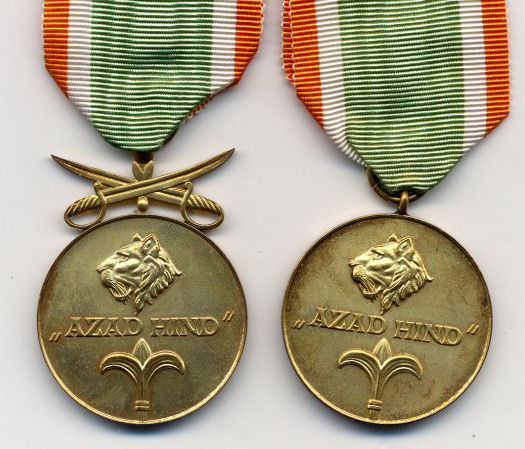
 0
0 -
b]Vir-i-Hind / Hero of India
Established in 1942. Awarded to soldiers in the Indian Legion or Indian National Army or civilians for acts of bravery (with swords) or distinguished service (without swords). This decoration carried with it an annual stipend of Rs. 200 when awarded with swords. It is estimated that only about one hundred of these decorations were manufactured in Europe; South-East Asian manufacturing has not been established. Known to have been awarded 11 times in Southeast Asia.
To understand the award better, a sample recipient would be S.O. Gurbachan Singh (who was, presumably, awarded the decoration with swords, though the description of his deed does not indicate this):
In 1944 ?by the end of May S.O. Gurbachan Singh was going in a boat with some Burmese boatmen to a certain place in Northern Burma.
?At some sound in the river, the enemy by chance opened fire and a bullet struck him just below his knee. One of the boatmen was also injured and the other two having lost their senses left rowing.
?Thirteen American soldiers fell upon the Sub-Officer to arrest him. S.O. Gurbachan Singh plunged into water and lying in concealment behind the boat, began to fire with his pistol. He fatally injured two of the enemy. All his four fingers with which he was resting on the boat got injured, but in spite of that he reloaded his pistol and opened fire again. Just then a bullet crushing his pistol went through the palm of his right hand injuring further his face and brow.
?Still he kept up his courage. With his wounded hand he shifted the boat slightly to the left and with this act saved the life of the two boatmen. After this, when he rowed across to the left bank, he discovered three dead bodies of the enemy soldiers ? the rest having fled.?
For this deed, S.O. Gurbachan Singh was also awarded the Tamgha-i-Shatru Nash, first class.
Illustrated here is an award without swords (obviously).
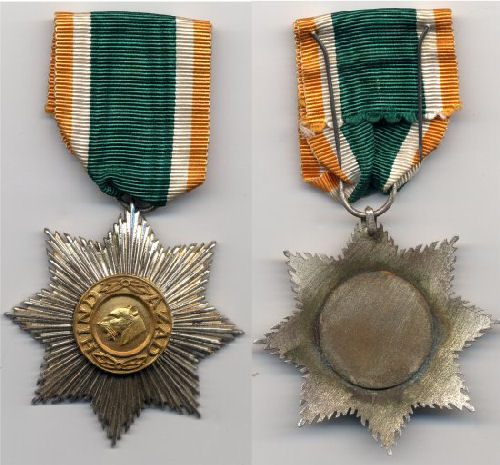
 0
0 -
Sardar-i-Jang / War Leader
Established 1942, although there is no sound evidence of awards prior to 1944. Awarded to soldiers in the Indian Legion or Indian National Army or civilians, already in possession of the Vir-i-Hind medal for additional or ongoing acts of bravery (with swords) or distinguished service (without swords). In this sense, the award was generally patterned on the German Iron Cross. There is good evidence that, at least in this case, the European and Asian awards differed substantially. The Southeast Asian variety existed in two classes and it is unclear how these relate ? if at all ? to the structure of the European award. This decoration carried with it an annual stipend of Rs. 250 when awarded with swords. It is estimated that only about one hundred of these decorations were manufactured in Europe; Southeast Asian manufacturing has not been established. Known to have been awarded 12 times in Southeast Asia.
To understand the award better, a sample recipient would be Major Pritam Singh (presumably awarded the medal with swords, though the citation does not specify this):
?Major Pritam Singh was commanding one unit of the A.H.F. [Azad Hind Fauj = Indian National Army] in Central Sector [of Burma]. This unit had instructions to penetrate the enemy positions and reconnoiter the enemy. He organized his unit and went on his errand early in May [1944?].
?When Major Pritam Singh and his party reached near their objective, the enemy opened fire on them with machine-guns and mortars. Not caring for the fire, they marched forward and with loud should of ?Chalo Delhi? [roughly, ?On to Delhi?] charged the enemy. After fulfilling the duty, with which he was entrusted, he ordered his men to retreat. But it was not an easy job to escape from so heavy fire. With a marvelous strategy, Major Pritam Singh was successful in bringing back his unit, with a very little loss. He also inflicted losses on the enemy.?
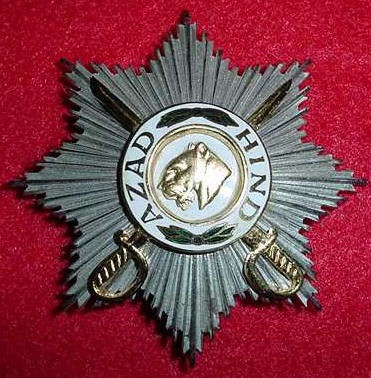
 0
0 -
Sher-i-Hind / Tiger of India
Established 1942, though the first documented award came only in 1944. Awarded to soldiers in the Indian Legion or Indian National Army or civilians, already in possession of the Sardar-i-Jang medal for additional or ongoing acts of bravery (with swords) or distinguished service (without swords). In this sense, the award was generally patterned on the German Iron Cross. This decoration carried with it an annual stipend of Rs. 300 when awarded with swords. It is estimated that only about one hundred of these decorations were manufactured in Europe; South-East Asian manufacturing has not been established.
To understand the award better, a sample recipient would Naik Kehar Singh (presumably an award with swords, but the citation does not specify this):
?On the 18th of May 1944, a unit of the I.N.A. was picqueting a hill in the central sector of the Indo-Burma frontier. Of those on duty, Naik Kehar Singh was one. On an early morning the enemy made an unprecedented pre-planned attack on our picquet.
?One of our comrades, who was working a light machine-gun against the enemy was fatally wounded by enemy fire. He signaled to his comrades to come and occupy his machine-gun. But the man who was to relieve him had already been shot dead by enemy fire. Naik Kehar Singh was witnessing all this from a short distance. He made a spontaneous decision.
?The enemy was firing uninterruptedly. But caring not for his own safety, he rushed through the pouring bullets to occupy the machine gun post. By the time he reached the post, the enemy had approached him to as close as ten yards. With a smile on his lips, Kehar Singh picked up the machine gun and resting it against his hip opened fire on the enemy who were shooting at him with a tommy gun.
?Neglecting the enemy fire, Naik Kehar Singh went on working his own machine gun, so much that the enemy had to retreat. At this he put the machine gun in position and went on firing to push the enemy back to complete retreat.?
The medal ? as well as the others ? was also awarded to German (and, one presumes, Japanese) officers and others involved with the Indian Legion and Indian National Army. For example, the famous late German phalerist Dr. K.-G. Kleitmann was awarded the Sher-i-Hind with swords. It is estimated that only perhaps twenty-five Sher-i-Hind medals were awarded, including two awards for Southeast Asia.
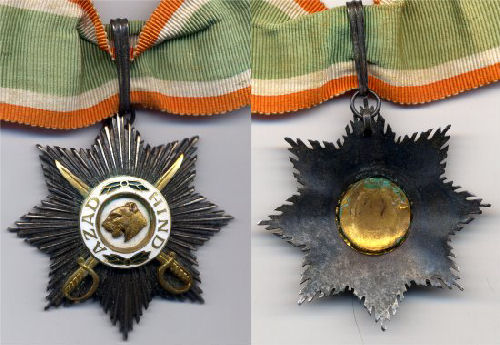
 0
0 -
Shaheed-i-Bharat / Martyr of India
Established in 1942. Awarded posthumously to all Indian soldiers who gave their lives in the armed struggle for Indian independence, 1942-45. The medal is sometime seen without swords, and this is almost certainly a fantasy manufacture. It is estimated that only about three hundred of these decorations were manufactured in Europe; South-East Asian manufacturing has not been established. Known to have been awarded 4 times in Southeast Asia.
This is a restrike from original dies by Rudolf Souval of Vienna.

 0
0 -
Whihe sometimes viewed as "Nazi" awards these are not, these are alliesd awards of the Provisional Government of Azad Hind [Free India] (PGAH). Established in Germany by Netaji Subhas Chandra Bose, the PGAH represents the sole pre-1947 issuance of awards by Independent India. (Well, there are a couple of medals issued by Congress for various Satyagraha campaigns, but....)
Will post PGAH awards here.
Ed
0 -
Oh, yeah, ribbon bars. May have them 180-degrees flipped?
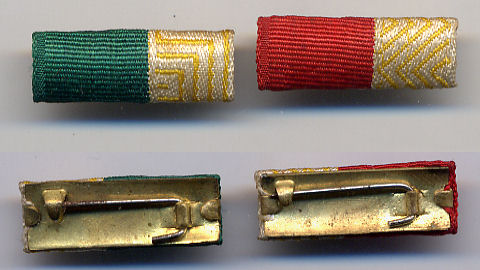
 0
0 -
Cased. Numbered 04673. No document or attribution
Awarded to junior officers for service in the Revolutionary War during the War of Liberation Period (3 September 1945 to 30 June 1950). In effect, this is the medal for the final phase of the Civil War.

 0
0 -
Reverse scan.
None of these scans are very good (or very large). Will dig it out if you need more info and better scans.
The Hohenzollernsche Denk?nze f?r K?mpfer von 1848/49 is, of course, flipped. The mounting on that one has gone "wonky". But as the mount is original, I am unwilling to "muscle" it around too much.
Ed

 0
0 -
Reverses.
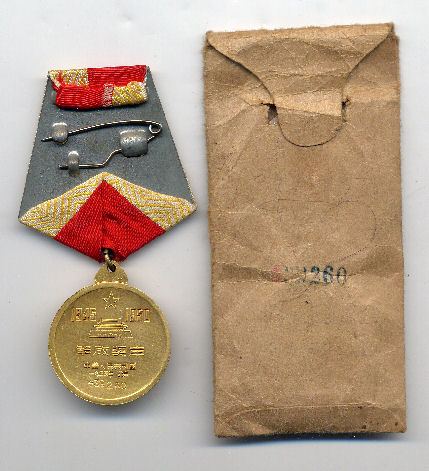
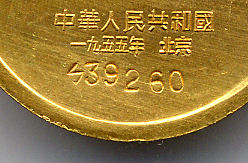

 0
0




PDRA - Medal of Ghazi Muhammad Ayub Khan
in South Asia
Posted
Another where I know nothing beyond the name.
Medal of Ghazi Muhammad Ayub Khan